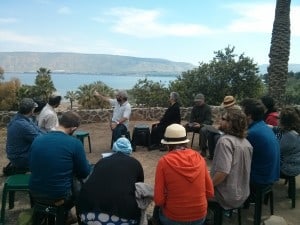by guest author Harriet Schiffer, Berkeley Moshav member

Our first day was a feast of new ideas and perspectives. In our first meeting with James he gave us a key to help us framework our journey. He entreated us to seek out the stories of the lives of the people in each place we visit and use those stories for inspiration and tachlis…
Tachlis. A new word for me meaning, practicality. We were to use others’ stories to inspire us and to help discover the tools that worked in each community facing unique challenges.
We traveled to Degania, the Mother of the Kibbutzim. Degania was the historical and classical springboard for all kibbutzim to come. We heard about young men (and some women) 16-18 making their way to Palestine to fulfill their Socialist Zionist dreams. Young, passionate, idealistic and determined. I thought about my grandfather who had travelled east across the Eurasian continent in those same years. He was escaping the same pogroms. In both situations, these young men had tough options before them and their lives seemed harsh. In both cases they were leaving family and all that was familiar behind. But my grandfather was completely alone and these young Socialist Zionists had each other. They had community. And that one observation about the strength that can come with finding community, stayed at the center of my day.
We left Degania and travelled up, and I mean WAY up to the town of Beit Jann. Beit Jann is one of 18 Druze villages, and home to some of the 120,000 Druze citizens of Israel. It is over 2000 years old.
I knew very little about the Druze people except I knew they serve in the Israeli army and I remember reading about the young Druze police officer who lost his life last summer, taking down the terrorist who murdered the rabbis in their Jerusalem shul. Our hosts welcomed us into their meeting hall and began by telling us a bit about Druze culture.
A young woman named, Maya, explained the significance of the colors of the five pointed star of the Druze. Green represents Earth. Blue is the sky and water. Yellow stands for the sun and wheat. Whies symbolizes purity and red is for love and coexistence.
Maya imparted that the Druze are an integral part of Israel and the Galil- past, present and future. And she made it clear that it is a cultural value of the Druze to live as loyal citizens of whichever country they inhabit. I found it fascinating that the Druze religion is kept completely secret from all but the religious sheiks. Still, the Druze people have lived according to their values of brotherhood, piece, solidarity and love.
The name of the intentional community we were visiting is Ofakim L’Atid. The idea for this community came from some of the Druze officers of the Israeli army. These officers serve proudly in the Israeli army and had risen to some of the highest ranks during their careers.
It was during their service that they began to notice the huge discrepancy between the lives of the Jewish- Israeli youths and those of the Druze-Israelis.
They were determined to form a community to turn around the lives of the children in their community. They put together an organization that would foster leadership development and engage youth in activities and programs that would change their communities and change their lives.
Ofakim L’Atid has been active in 8 of the 18 communities. The 170 youth in their 7’clubs have collectively given 30,240 hours of volunteer work in their community.
One of the many, many community building projects that these youth leaders run was cleaning up Yitro’s grave. Yitro’s was Moshe’s father-in-law and one of the Druzes’ five prophets.
I felt I’ve already done one full week in this one long day. This is an amazing, amazing experience and I cannot imagine all that is yet to come. I am so grateful,to be on this journey.
This is Ibble dibble Harriet with no Ibble dibbles saying goodnight.
Learn more about the Jewish Intentional Communities Initiative here.




Comments are closed.